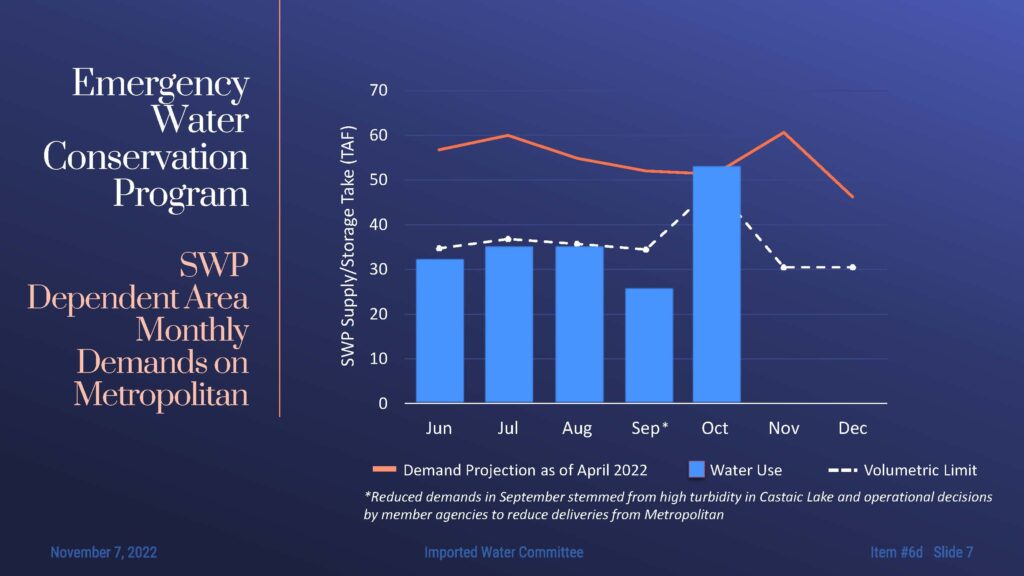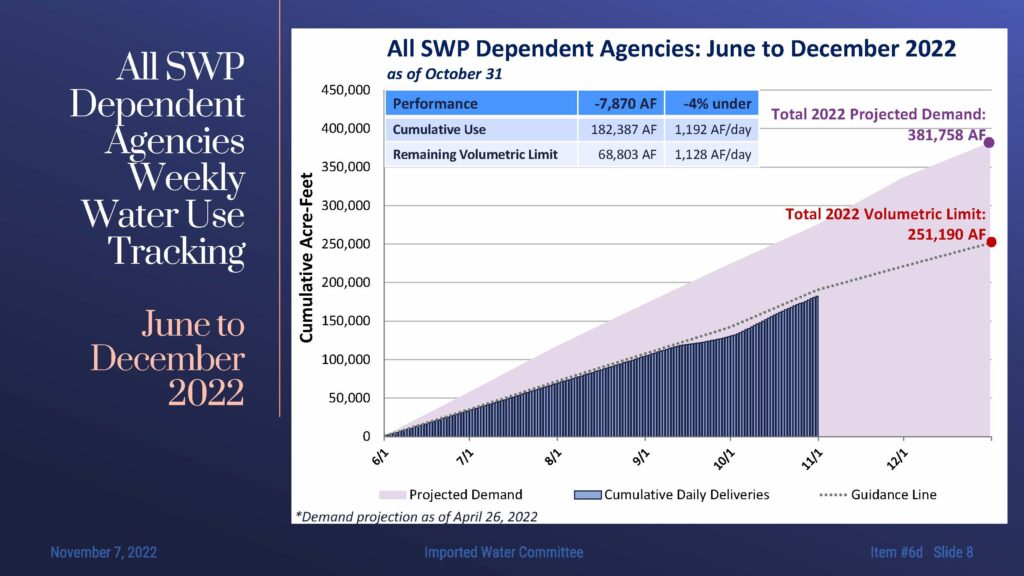“As we look at the supply outlook for the next year, we again stress the importance of our member agencies in preparing their governing bodies and communities for mandatory restrictions this next year,” said Noosha Razavian, Associate Resource Specialist.
At the November meeting of Metropolitan’s Imported Water Committee, staff briefed committee members on the Colorado River’s worsening conditions and what Metropolitan’s water supplies look like as staff prepares for a dry 2023.
Key takeaways:
- Reclamation is preparing a supplemental environmental impact statement to revise the 2007 interim guidelines which govern the operation of Lake Mead and Lake Powell. Alternatives being analyzed are a consensus alternative, an alternative Reclamation would implement if consensus is not reached, and a no action alternative.
- In response to Reclamation’s call for increased conservation of Colorado River water last June, California has proposed cutting 400,000 acre-feet each year from 2023 to 2026. The details of how much each entity will contribute to the cutback are being worked out. Metropolitan is proposing to use the capacity in its fallowing programs in Palo Verde Irrigation District and Bard Water District for its contributions.
- Storage supplies at face value are enough to cover the gap between water supply and demand next year, but those supplies are largely on the Colorado system and not accessible to all agencies. In addition, Metropolitan’s goal is to minimize the delivery of ICS water in Lake Mead. Bottom line, Metropolitan is not planning for a full Colorado River aqueduct for next year or any foreseeable year in the future.
- Restrictions for the State Water Project-dependent areas will likely continue for the foreseeable future. Similar restrictions are likely for the remainder of Metropolitan’s service area in 2023, as available supplies will need to be allocated throughout the entire service area to manage or reduce diversions from the Colorado River.
- At the December meeting, staff will bring a board resolution for approval that will further reaffirm the drought emergency condition for the service area and call for an enhancement of the current voluntary conservation efforts.
- “As we look at the supply outlook for the next year, we again stress the importance of our member agencies in preparing their governing bodies and communities for mandatory restrictions this next year,” said Ms. Razavian, Noosha Razavian, Associate Resource Specialist.
Update on Colorado River 2007 Interim Guidelines Supplemental Environmental Impact Statement
Program Manager Shanti Rosset updated committee members on Reclamation’s notice on October 28 to prepare a supplemental environmental impact statement for revision of the 2007 Interim Guidelines.
The 2007 interim guidelines are the rules Reclamation uses to operate Lake Powell and Lake Mead. The guidelines define tiers for the coordinated operations of the two reservoirs and are used to determine the volume of annual releases from Glen Canyon and Hoover Dam. In addition, the guidelines include shortage provisions that set the tiers to determine when Arizona and Nevada would take shortages and the volume of those shortages. The guidelines also established Intentionally Created Surplus or ICS storage in Lake Mead.
Reclamation’s notice of intent describes the need for changes to the operations of both Glen Canyon and Hoover Dams in 2023 and 2024 to address the impacts of low runoff conditions that pose unacceptable risks to the operation of the dams. Reclamation’s notice indicated that revisions to the guidelines may include reduced annual releases from Glen Canyon Dam, changes to shortage provisions, and changes to the volume of water available for consumptive use for Arizona, Nevada, and California.
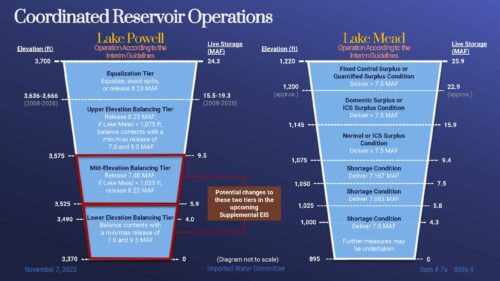 The diagram below shows the tiers that govern the coordinated operations of Lake Powell and Lake Mead. The SEIS will analyze modified and/or reduced releases from both the mid-elevation release tier and the lower elevation balancing tier. Specifically, Reclamation is looking at making less than 7 million acre-feet releases from Glen Canyon Dam to protect elevation 3490 in Lake Powell.
The diagram below shows the tiers that govern the coordinated operations of Lake Powell and Lake Mead. The SEIS will analyze modified and/or reduced releases from both the mid-elevation release tier and the lower elevation balancing tier. Specifically, Reclamation is looking at making less than 7 million acre-feet releases from Glen Canyon Dam to protect elevation 3490 in Lake Powell.
The SEIS will analyze reduced deliveries to Arizona, Nevada, and California in the shortage tiers for Lake Mead.
Ms. Rosset noted that the current guidelines don’t define how shortages will be taken in Lake Mead below elevation 1025.
Reclamation’s Notice of Intent identified three primary alternatives that will be analyzed in the SEIS:
- The framework agreement alternative, a consensus alternative that builds on the commitments made by basin states, tribes, and NGOs in the 2019 drought contingency plan;
- The reservoir operation alternative, Reclamation’s alternative if a consensus alternative isn’t reached or is insufficient to protect dam infrastructure; and
- A no-action alternative.
Ms. Rosset concluded her presentation by noting that the Bureau of Reclamation anticipates having a final SEIS and a record of decision by July next year. Metropolitan staff will participate in the development of the framework agreement alternative.
Director Russell Lefevre (Torrance) asked if Metropolitan was in danger of losing access to its ICS supplies.
“Because the releases from Lake Mead are subject of this SEIS, those could impact tier determinations, which could impact our contractual obligations under the DCP,” she said. “That is a possibility, but it wouldn’t directly amend the DCP. But it could change tier determinations which could have that impact indirectly.”
California’s proposal to cut 400,000 acre-feet of Colorado River water
Bill Hasenamp, Manager of Colorado River Resources, next updated the committee on California’s proposal to cut back 400,000 acre-feet and how Metropolitan is planning to contribute.
In June of this year, the Commissioner of the Bureau of Reclamation announced that Colorado River water users needed to cut between 2 to 4 million acre-feet in 2023 and gave the basin states until August to develop a plan.
Mr. Hasencamp said Metropolitan and the other states took the call seriously. The seven states met together regularly, and the lower basin states met weekly, trying to devise a plan that could be that significant on short notice.
“We were close,” he said. “We had some proposals that came close to 2 million but couldn’t meet the deadline by August. And then it seems at that point, discussion stalled. The other states stopped engaging with California in trying to develop a proposal. So the California agencies decided we would go ahead with our own proposals, whether the other states develop one or not.”
On October 5, California sent a letter offering to voluntarily reduce the state’s Colorado River use by 400,000 acre-feet a year from 2023 through 2026.
“That’s on top of our required DCP contributions, which if Lake Mead were to fall to below 1030, which the 24-month study says it is projected to do, that would be another 350,000 acre-feet of cuts annually starting in 2024,” he said. “So, a total of 750,000 acre-feet of cuts from California for the last three years of the interim period. To put that in perspective, that’s 17% from our basic apportionment and 30% compared to the water we used 20 years ago in 2002.”
To help the basin states meet the reduction, the passage of the Inflation Reduction Act included funding for short and long-term solutions. Later this month, proposals are due for the short-term solutions, defined as conservation through 2026. Phase two proposals will be due next year for the longer-term projects that will provide benefits beyond 2026.
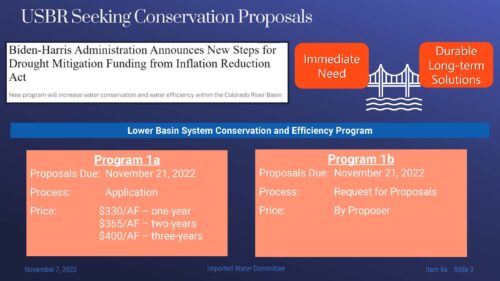 For the short-term proposals, there are two programs. Program 1a is a pre-set price set by the Reclamation that offers $330 an acre-foot if the project conserves water for one year and increases to $400 an acre-foot if the project is three years. Alternatively, if an agency thinks that that pre-set price isn’t sufficient, they can provide their own proposal under Program 1b. Reclamation has requested any proposal under 1b be very detailed, explaining why the funding available in 1a isn’t enough. The expectation is that the vast majority of funding will be under Program 1a.
For the short-term proposals, there are two programs. Program 1a is a pre-set price set by the Reclamation that offers $330 an acre-foot if the project conserves water for one year and increases to $400 an acre-foot if the project is three years. Alternatively, if an agency thinks that that pre-set price isn’t sufficient, they can provide their own proposal under Program 1b. Reclamation has requested any proposal under 1b be very detailed, explaining why the funding available in 1a isn’t enough. The expectation is that the vast majority of funding will be under Program 1a.
Metropolitan has been meeting with the other agencies to devise a plan to conserve 400,000 acre-feet. Imperial Irrigation District and Coachella Valley Water District are developing their own proposals.
“We are proposing a joint proposal with our partners in Bard Water District and Palo Verde Irrigation District,” said Mr. Hasencamp. “Since we have existing programs with both of those entities, we would then use our existing program to help provide extra water to Lake Mead.”
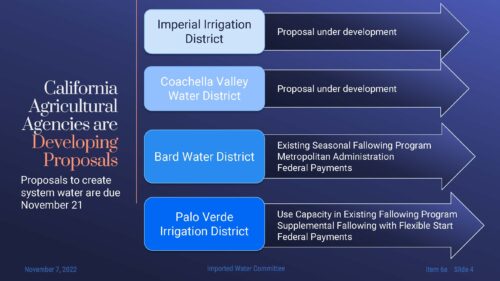 Participation in Metropolitan’s program with the Bard Water District has been dropping. With that program, Metropolitan makes a fallowing call, and farmers voluntarily decide whether they want to participate.
Participation in Metropolitan’s program with the Bard Water District has been dropping. With that program, Metropolitan makes a fallowing call, and farmers voluntarily decide whether they want to participate.
“Because commodity prices have been high, based on our payments, the participation has been lower,” said Mr. Hasencamp. “If the federal government comes in and funds the seasonal fallowing program, we think there would be a lot more participation and a lot more benefit to Lake Mead. So what we propose to do with Bard Water District is let the federal government make the fallowing calls through 2026.”
“With Palo Verde Irrigation District, we also would use the capacity in our existing fallowing program,” he continued. “We have been at low fallow and calls for our own use here in Southern California, leaving capacity within the program available. Last year, your Board approved a two-year deal with PVID to increase the following and have that water saved in Lake Mead as part of the 500 Plus plan. So under the current discussions with PVID, we would avoid making additional fallowing calls through 2026. I think we are at about a 50% following level for the next year and a half, then drop down to 25%. So the funding under 1a would be available for the supplemental fallowing. And the supplemental fallowing will be both fallowing within our existing cap… then some amount above that, that voluntarily, farmers can exceed the existing call to provide even more savings.”
He noted that Metropolitan is the largest landowner in the valley at 20% of the irrigated lands. So Metropolitan’s land would be available for fallowing at the same rate as the rest of the valley and receive funding from the federal government to offset fallowing impacts.
“All that saved water would stay in Lake Mead,” said Mr. Hasencamp. “The actual amount of water depends on the voluntary participation and as our call changes, but it ranges from perhaps 75,000 acre-feet a year to over 100,000 acre-feet a year.”
Metropolitan’s goal is to minimize the delivery of ICS water in Lake Mead. For the last two years, Metropolitan has been taking ICS water out of Lake Mead, something Metropolitan had the right to do, although he acknowledged the move was criticized.
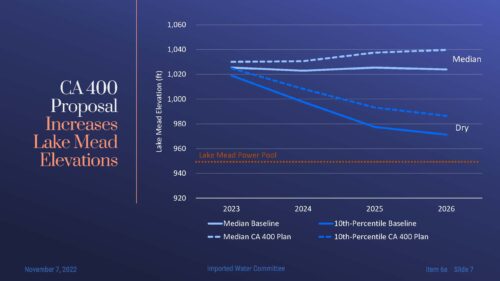 “So as part of the plan to reduce California down to 4 million acre-feet, the agricultural entities would use 400,000 less, and then Metropolitan would have a goal of not taking ICS out so we can keep our use down at 4 million,” Mr. Hasencamp. “And under that range of not taking ICS out and not making additional fallowing calls, our supply ranges between 900 and a million acre-feet a year, based on the available supplies we have within California.”
“So as part of the plan to reduce California down to 4 million acre-feet, the agricultural entities would use 400,000 less, and then Metropolitan would have a goal of not taking ICS out so we can keep our use down at 4 million,” Mr. Hasencamp. “And under that range of not taking ICS out and not making additional fallowing calls, our supply ranges between 900 and a million acre-feet a year, based on the available supplies we have within California.”
While the ICS water will be available for unanticipated changes, the goal is voluntarily not to take it and leave it in Lake Mead. DCP contributions, in all likelihood, will be significant, so the ICS will help meet those contributions.
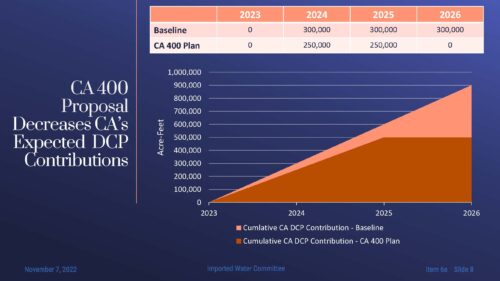 California’s proposal is just one piece of what will hopefully be a much larger state proposal, but it does impact Lake Mead. “Reclamation is saying under median conditions, we could level off at around 1021 feet in Mead, but our actions could raise it by almost 20 feet,” noted Mr. Hasencamp. “Under dry conditions, Lake Mead could get close to the power pool limit. But again, our actions alone would raise it by about 20 feet. So there is a definite positive impact on Lake Mead from our plan. And we know others will be participating besides California.”
California’s proposal is just one piece of what will hopefully be a much larger state proposal, but it does impact Lake Mead. “Reclamation is saying under median conditions, we could level off at around 1021 feet in Mead, but our actions could raise it by almost 20 feet,” noted Mr. Hasencamp. “Under dry conditions, Lake Mead could get close to the power pool limit. But again, our actions alone would raise it by about 20 feet. So there is a definite positive impact on Lake Mead from our plan. And we know others will be participating besides California.”
He also pointed out the benefits of boosting the level of Lake Mead. “The more we can keep the levels from crashing to lower levels, the less total volume of DCP contributions we would have to make. Under the base case, this is about 900,000 acre-feet through 2026. But with our plan, that might be reduced to 500,000. There are many ranges and ifs and whats, but in general, the concept here is that the more we can make voluntary smaller cuts now, the more likely we are to avoid making bigger cuts in the future.”
As for the next steps, staff will continue to work with Bard Water District and Palo Verde Irrigation District to submit joint proposals to the federal government by November 21. Imperial Irrigation District and Coachella Valley Water District will submit their proposals independently. If Reclamation approves those proposals, they will develop the necessary implementing agreements and seek board authorization in early 2023.
Southern California water supplies
Noosha Razavian, Associate Resource Specialist, updated committee members on Metropolitan’s current water supply-demand balance, the emergency water conservation program, and staff’s planning efforts for 2023.
Current water supply-demand balance
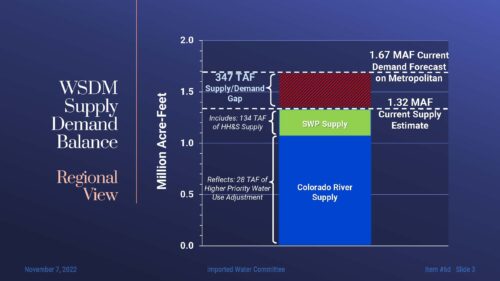 The current water supply estimate is approximately 1.32 million acre-feet, which includes the current Colorado River Aqueduct estimate adjusted for the higher priority water use, the 5% State Water Project table allocation, 134,000 acre-feet of human health and safety supplies, and the latest estimate for transfer supplies.
The current water supply estimate is approximately 1.32 million acre-feet, which includes the current Colorado River Aqueduct estimate adjusted for the higher priority water use, the 5% State Water Project table allocation, 134,000 acre-feet of human health and safety supplies, and the latest estimate for transfer supplies.
The higher priority water use adjustment has shifted from negative 16,000 acre-feet last month to a positive 28,000 acre-feet this month. Ms. Razavian reminded this is an estimate and that the value may fluctuate greatly as the end of the year approaches.
“Our current take capacities for Central Valley programs are around 100,000 acre-feet this year,” she said. “We’d also like to note that our take capacities are influenced by things like our statewide project allocation, water quality issues, and any other agencies who may also have partnerships with some of our Central Valley partners.”
Current demand is projected to be around 1.67 million acre-feet, leaving a gap of about 347,000 acre-feet. Actions such as storage withdrawals and water purchases continue to help supplement supplies this year, and conservation efforts across the region continue to reduce demand.
Emergency water conservation program
No penalties have been issued for any path two agencies thus far, and path one compliance requirements will remain at one day a week watering through the end of this year.
Monthly water use within the dependent area was below both the projected demand and the volumetric limits for each of the respective months. Ms. Razavian noted that at first glance, October demands surpassed the October volumetric limit and the projected demand. However, the downtick in demand in September stemmed from high turbidity within Castaic Lake and operational decisions by the city of Los Angeles to reduce deliveries from Metropolitan and rely more on local supplies during that time. So a portion of the uptick in demand by the city of Los Angeles this month was to compensate for the issues faced back in September. Upper San Gabriel also took their full 2022 allocated state supplies during October.
At the end of October, the State Water Project dependent area used around 182,000 acre-feet of water and is currently trending about 4% below the total 2022 volumetric limit.
2023 water supply outlook
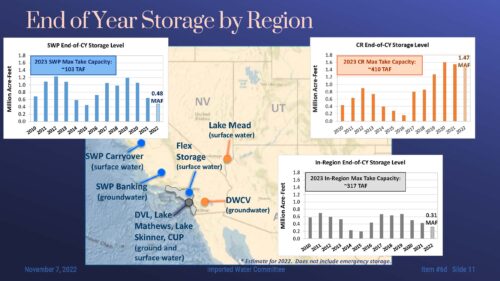 Staff is projecting to end the calendar year with approximately 2.3 million acre-feet of region-wide dry year storage, which will help manage the supply-demand gap. However, these storage supplies are not evenly distributed across their State Water Project, Colorado River, and in-region assets; instead, most storage supplies are concentrated in their Colorado River supplies. And further, not all the projected 2.3 million acre-feet of storage will be accessible to Metropolitan in 2023.
Staff is projecting to end the calendar year with approximately 2.3 million acre-feet of region-wide dry year storage, which will help manage the supply-demand gap. However, these storage supplies are not evenly distributed across their State Water Project, Colorado River, and in-region assets; instead, most storage supplies are concentrated in their Colorado River supplies. And further, not all the projected 2.3 million acre-feet of storage will be accessible to Metropolitan in 2023.
“When we assume a 5% State Water Project allocation for 2023, the maximum take capacities and operational limitations for each of these three regions put constraints on the storage available for us to draw upon,” said Ms. Razavian.
Staff continues to anticipate a low initial State Water Project Table A allocation at the beginning of next year. Limited State Water Project storage, including depleted flexible storage and low amounts of carryover, are all driving factors as to why the acute shortage of State Water Project supplies to meet the demands of the dependent area will continue to persist into the first part of 2023.
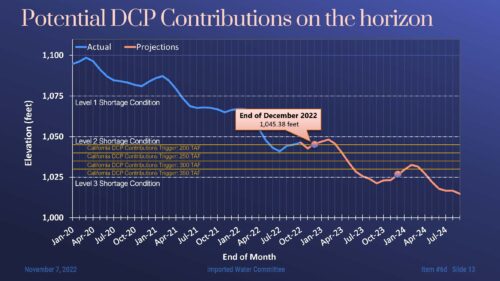 The diagram shows the actual and projected physical elevation levels at Lake Mead and illustrates the drastic decline in supplies in the past two years, as well as the projected continuation of the decline into the future. The diagram shows the current projected physical elevation level for 2022 to be around 1045.38 feet end of December. Reclamation has declared the first level 2A shortage, meaning that Arizona, Nevada, and Mexico will all be required to make DCP contributions next year. In addition, the projections show how much more Lake Mead levels may fall by the end of 2023 if the status quo continues.
The diagram shows the actual and projected physical elevation levels at Lake Mead and illustrates the drastic decline in supplies in the past two years, as well as the projected continuation of the decline into the future. The diagram shows the current projected physical elevation level for 2022 to be around 1045.38 feet end of December. Reclamation has declared the first level 2A shortage, meaning that Arizona, Nevada, and Mexico will all be required to make DCP contributions next year. In addition, the projections show how much more Lake Mead levels may fall by the end of 2023 if the status quo continues.
“So when we look at our supply outlook for the Colorado River, the bottom line is that Metropolitan is not planning for a full Colorado River aqueduct for this next year or any foreseeable year in the future,” said Ms. Razavian. “There are many reasons why this may be the case. Metropolitan will access ICS supplies to meet our future DCP contributions that are on the horizon. But for the time being, any additional use of ICS supplies to meet the demands of our service area remains quite uncertain.”
She also noted that California recently submitted a proposal to reduce Colorado River use by 400,000 acre-feet annually for 2023 through 2026. The recent proposal may also decrease California’s expected future DCP contributions.
Reclamation is continuing to evaluate options for delivery reductions for California, Arizona, and Nevada next year, including allocating system losses based on proportionate evaporation amounts or reevaluating beneficial use standards that consider fundamental human health and safety requirements.
These supply outlooks require a more thorough discussion, so next month, staff will be bringing three items for consideration:
- The first item is an update on any potential adjustments to the Emergency Water Conservation Program, which the Board approved for the State Water Project-dependent areas through June 2023. At the December committee meeting, staff will provide an update on any potential adjustments to the existing framework based on discussions with the dependent area member agencies. Staff will also provide updated volumetric limits for next year, including human health and safety supplies and other available supplies.
- The second item is a discussion on the implementation of the region-wide water supply allocation plan for 2023. On a region-wide scale, it’s become increasingly clear that a water supply allocation plan will be needed for the entire service area this next year to manage or reduce diversions from the Colorado River. The water supply allocation plan is the current Board policy for regional allocations; it was first adopted by the Board in 2008 and further implemented in 2009, 2010, and 2015; it has been updated several times. So in December, staff will begin the discussions on a regional Water Supply Allocation Plan and its implementation for 2023.
- The third item is an action item and resolution that will stress the need for an immediate and voluntary reduction in outdoor water use and the extraordinary conservation efforts needed by the blended and Colorado River-exclusive areas (essentially, everywhere else except the State Water Project-dependent areas). In November 2021, the Board declared a regional drought emergency for the entire service area; an April 2022 board resolution called for increased conservation to meet Governor Newsom’s March executive order. The December board action will further reaffirm the drought emergency condition for the service area and call for an enhancement of the current voluntary conservation efforts.
Ms. Ravazian concluded with key takeaways:
The Emergency Water Conservation Program will continue into January 2023. Metropolitan staff submitted water orders for 2023, which included a request for human health and safety water for the next year. More information on the initial State Water Project allocation is expected in the coming weeks.
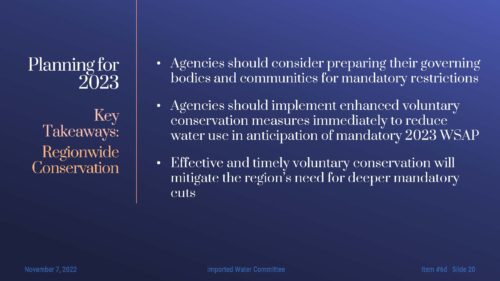 Staff will continue discussions with the member agencies on the Emergency Water Conservation Program’s supply allocation methodology for the available supplies. Those discussions will be further illuminated in next month’s board item when staff discusses the volumetric limits for 2023 and any potential new or revised compliance mechanisms for the program.
Staff will continue discussions with the member agencies on the Emergency Water Conservation Program’s supply allocation methodology for the available supplies. Those discussions will be further illuminated in next month’s board item when staff discusses the volumetric limits for 2023 and any potential new or revised compliance mechanisms for the program.
“As we look at the supply outlook for the next year, we again stress the importance of our member agencies in preparing their governing bodies and communities for mandatory restrictions this next year,” said Ms. Razavian. “Further, agencies should immediately implement enhanced voluntary conservation measures to reduce water use in anticipation of a mandatory 2023 Water Supply Allocation Plan. Moreover, effective and timely voluntary conservation efforts will help to mitigate the region’s need for even more severe mandatory cuts this next year.”
Board discussion
Director Tim Smith (San Diego) notes that at last month’s meeting, he had asked for an analysis of water supplies for 2023 and 2024 that shows available supplies on a timeline so board members can more clearly see the potential gaps and begin to develop a plan to address it. However, staff is moving rapidly into planning for mandatory actions even though this analysis has not been provided. Moreover, planning efforts seem to focus solely on how to implement cutbacks rather than an effort to add to the available water supply.
 “So when this comes back next month, I’d like to see the table laying out the probability and timeline for DCP and ICS contributions through 2026, including the amount of water MWD is seeking to create through voluntary or mandatory measures so that we can start looking longer down the road than just 2023,” he said. “We need real volumes of water that MWD is seeking to create so we can form a fair and reasonable method to get to the actual goal. If we don’t have a goal, we’re in the dark.”
“So when this comes back next month, I’d like to see the table laying out the probability and timeline for DCP and ICS contributions through 2026, including the amount of water MWD is seeking to create through voluntary or mandatory measures so that we can start looking longer down the road than just 2023,” he said. “We need real volumes of water that MWD is seeking to create so we can form a fair and reasonable method to get to the actual goal. If we don’t have a goal, we’re in the dark.”
General Manager Adel Hagekhalil noted that a lot of it is dependent on the cutbacks on the Colorado River and things that are still uncertain, but staff will provide all the available information at the December meeting. He said there would be more dialogue with member agency managers before they move forward with any cuts. They will bring a timeline with a water supply gap, a storage gap, and a conveyance gap for the discussion on how to move forward. More information is coming soon from the state on the State Water Project allocation, as well as from Reclamation as to how to move forward with cutbacks for California and Metropolitan.
Director Marty Miller (San Diego) echoed the concern that the only planning being done is to cut back water supply deliveries to member agencies and customers who rely on them. The November 2021 board memo and resolution included the statement that the needs of MWD’s member agencies vary widely depending on their geographic location, available local supplies, and prior investments to secure water reliability. How is this being included in the planning for 2023?
“We know each member agency is unique, and we want to make sure that what we provide is the flexibility for the member agency to respond to this without having a one-size-fits-all type of action,” said General Manager Hagekhalil. “We’ll provide the member agencies the flexibility to adapt based on their unique conditions.”
Director Miller asked if the staff has concluded that there are no more opportunities available to secure new water or, if so, should the Board be told about them so we can decide if we want to pursue them? Is it a matter of money that stops us from going after those new supplies?
Deven Upadhyay, Assistant General Manager and Chief Operating Officer, pointed out that the Board adopted a water supply allocation plan specifically for these circumstances, so it isn’t like the planning hasn’t been done. Metropolitan has implemented the plan several times and has updated the plan over the years to incorporate lessons learned.
“The plan that’s been in place has a series of steps that we would walk through that do, in fact, honor local investment,” said Mr. Upadhyay. “Agencies that have more local supplies that have invested and have been able to develop those local supplies aren’t asked to reduce to the same degree as other agencies that are more reliant on imported supplies, so it tries to balance those things. But we started this off at the last member agency managers meeting, talking with your managers about the plan, to dust it off again because it’s been a few years since we had to implement it, and see if any adjustments need to be made.”
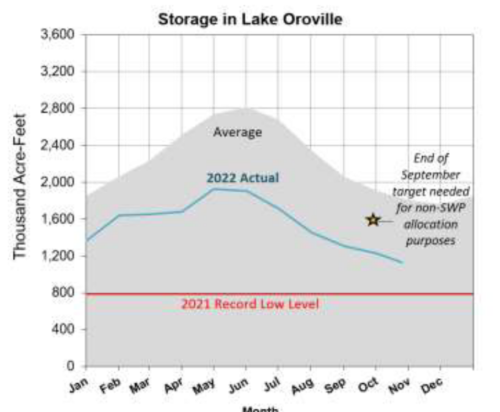 Typically, staff works through the wintertime; the State Water Project allocation might vary as the winter plays out. “As we start to hone in on what the State Water Project supplies look like, we can have the conversation with you about what percentage reduction is needed and where each agency, as part of the plan, has a slightly different percentage based on their investments and what they’ve done.”
Typically, staff works through the wintertime; the State Water Project allocation might vary as the winter plays out. “As we start to hone in on what the State Water Project supplies look like, we can have the conversation with you about what percentage reduction is needed and where each agency, as part of the plan, has a slightly different percentage based on their investments and what they’ve done.”
Mr. Upadhyay said they haven’t given up hope on being able to acquire additional supplies. Last year, the Board authorized the general manager to pursue State Water Project transfers in particular, but there just wasn’t a lot available to acquire. So they are working to see what’s available for 2023, and they will bring an item for board approval that will allow staff to pursue water transfers again for the upcoming year.
Mr. Hagehkalil said the discussion needs to focus on a comprehensive, holistic plan for water supplies over time, along with the risks. “It’s going to take us all on the Board agreeing on what protection we need to have for the future. Do we want to deal with similar issues like this in the future, or do we want to shore up our water supplies and invest more? … At the end of the day, we have to come up with a plan to say, this is what we managed for, this is the risk that we’ll take, and this is the protection we will provide to our member agencies across the Board. So I look forward to that dialogue with you.”
Director Barry Pressman (Beverly Hills) closed the meeting with the comment, “I don’t see it as an either-or; conservation or new water. I see it’s all hands on deck to do everything we can to get through the crisis. And new water is a good part of that. So if we can find it … I don’t think that excludes conservation or vice versa.”
11072022 IW 6d Report


